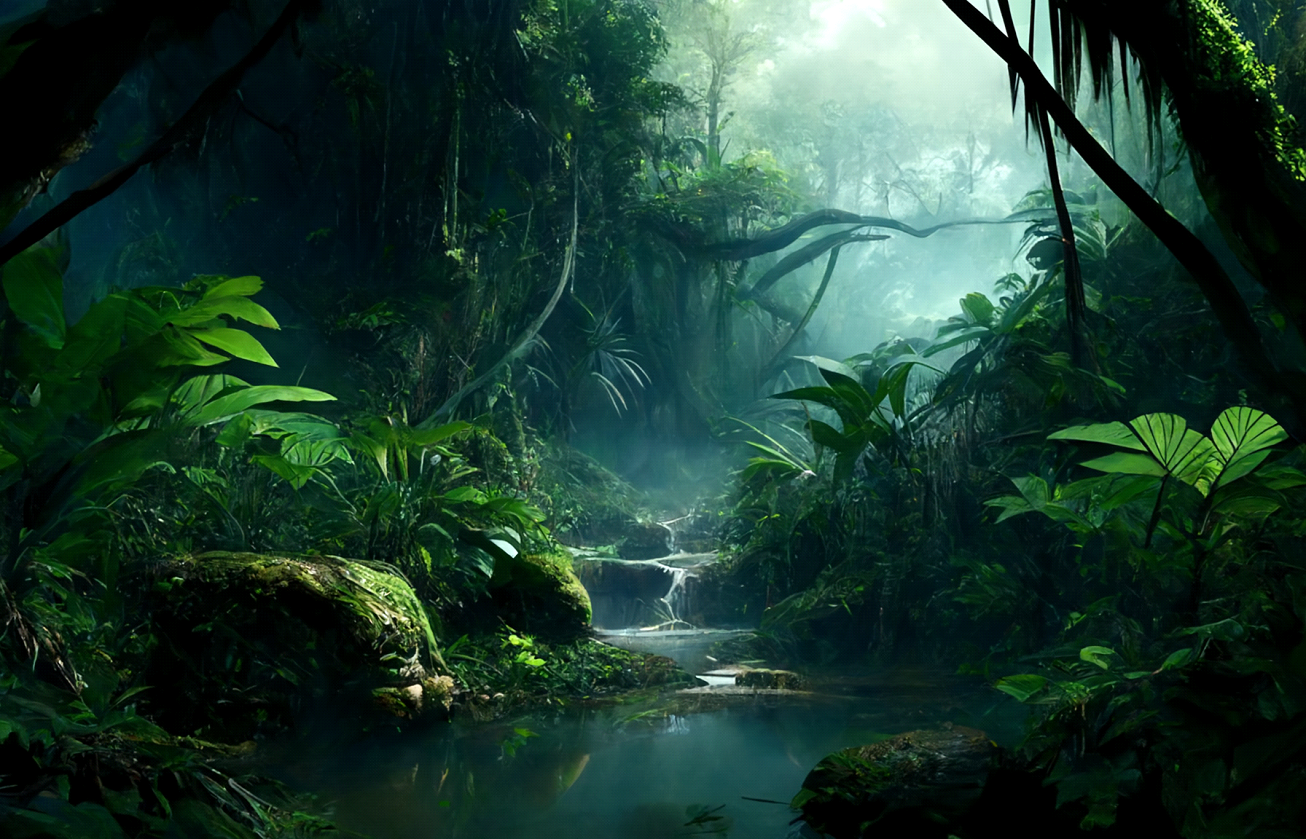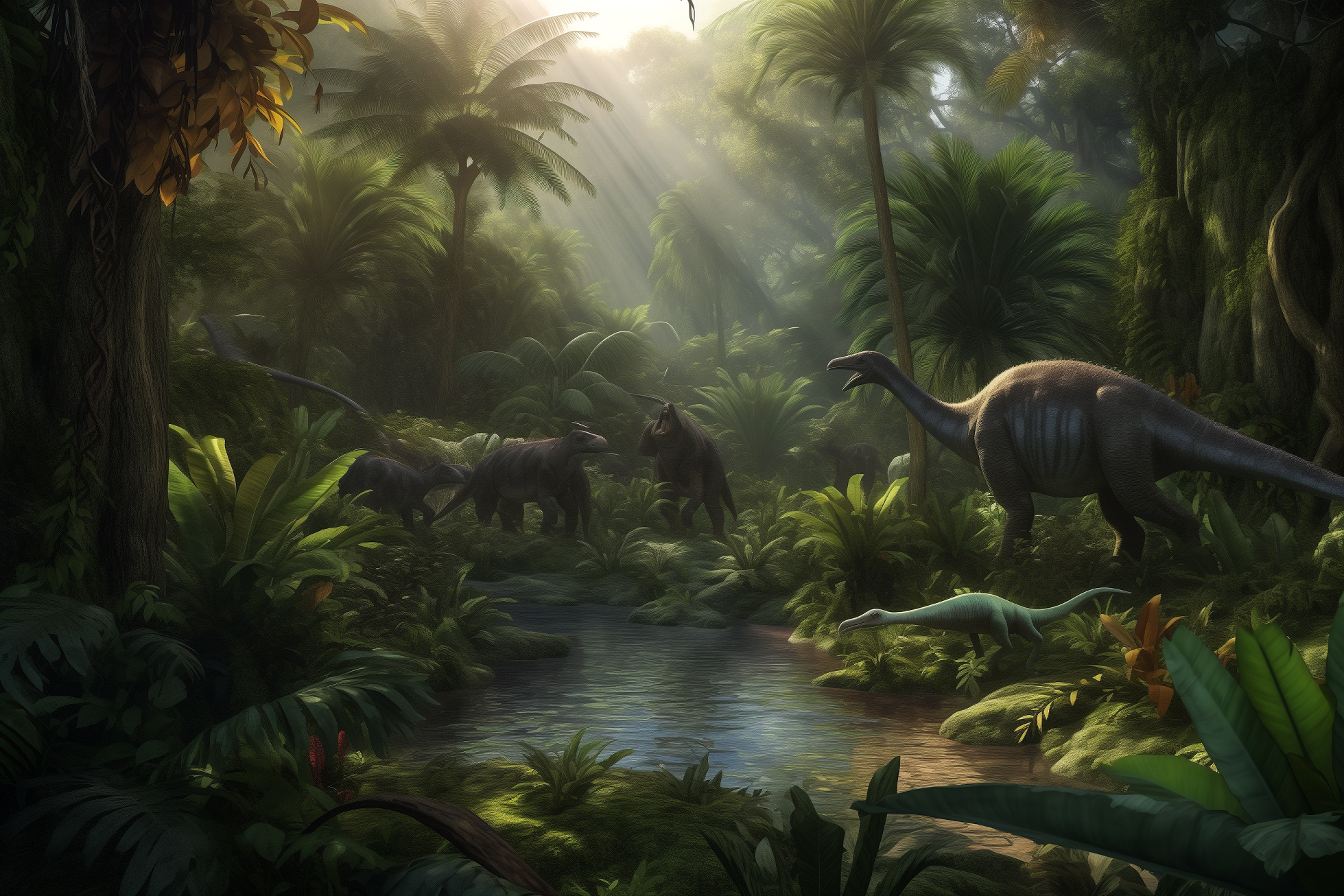To’unga
Pronunciation: TOO-unga
Map Index: J5, J6
Location: South central Centakus
Geography: The land of To'unga, located in the heart of south-central Centakus, remains a mysterious and virtually impenetrable wilderness. This region, shrouded in ancient jungles, holds secrets known to few outsiders. Its unique geography, climate, and inhabitants set it apart from the rest of the world.
To'unga's geography is dominated by dense, nearly impenetrable jungle, making it a treacherous and uncharted territory. Dominated by towering trees, dense undergrowth, and twisting vines, travel and navigation presents a daunting challenge for explorers.
To'unga's rivers boast broad, nearly level floodplains. Sudden and massive floods can occur without warning, often triggered by distant storms upstream.
In the Gulugg Highlands, vast herds of large dinosaurs thunder across the elevated plains. In many areas, great clouds of swarming insects fill the skies, some of which grow to enormous size.
Primary Population: None
Secondary Population: None
Minor Population: None
Climate: The tropical rainforest climate makes it hot and steamy year-round. Annual rainfall exceeds 250 inches, resulting in numerous lakes and fast-flowing rivers. The climate has two distinct seasons. In the rainy season, frequent floods are common as thunderous rainfall events happen daily. During the dry season, intermittent rainfall still occurs that provides sufficient moisture for the jungle's needs.
Wildlife: The rainforest is home to a large number of brilliantly colored birds, including toucans and parrots. Monkeys live in the trees, while jaguars and giant anacondas silently hunt their prey on the forest floor. The jungle also host large numbers of exotic insects.
Humanoids: The Vlessh, a primitive saurian-like humanoid race, ocasionally visit the To'unga Jungle. They have no permanent habitations here, but only make brief forays to procure items they need.
Monsters: The creatures of the great jungle of To'unga, holdovers from the Second Age of Raios are found only in the southern rainforests of Raios and nowhere else. The great apex predators include the ever dangerous Allosaurus, Ceratosaurus, Giganotosaurus, and Tyrannosaurus, who all have mouths filled with large sharp teeth. Smaller predators include Deinonychus, Dimetrodon, Megaraptor, Troodon, and Velociraptor. These creatures are smaller but no less dangerous than the apex predators. Extremely large herbivores, some of which graze treetops, include Amargasaurus, Brachiosaurus, Brontosaurus, Compsognathus, Diplodocus, Iguanodon, and Parasaurolophus. The most common flying creature is Quetzalcoatlus with an impressive 40 foot wingspan. Areas of freshwater are home to the great predator Spinosaurus with its unique sail-like structure on its back. In coastal waters there is still tremendous danger as there are quite a few great predators that are large enough to attack ships. These include Elasmosaurus, Kronosaurus, Nothosaur, Plesiosaurus, and Tylosaurus. On the unique ecosystem atop the Gulugg Highlands, massive herds of triceratops graze the grass covered thin soils as a few Ceratosaurus follow the herd looking for stragglers.
History: Remarkably, the Great Cataclysm's impact on To'unga was relatively minor. Chaos storms spared this southern expanse, and the earthquakes left little lasting damage to the untamed jungle wilderness. While portions of the coastal regions sank below sea level, in other areas, such as the Gulugg Highlands, sudden dramatic uplift took place, transforming the nearly level wet low jungle into elevated well drained tropical plains.
Today: To'unga's great isolation and perilous terrain have preserved its enigmatic beauty and prehistoric inhabitants, making it a land of wonder and danger, awaiting the brave or foolhardy who dare to explore its vast uncharted depths.The Gulugg Highlands experienced violent uplift during the Great Cataclysm. This great area, thrust upwards, forms a great plateau that stands today as a highly dissected grassy plain in the northern portion of To'unga.
Map Index: J5, J6
Location: South central Centakus
Geography: The land of To'unga, located in the heart of south-central Centakus, remains a mysterious and virtually impenetrable wilderness. This region, shrouded in ancient jungles, holds secrets known to few outsiders. Its unique geography, climate, and inhabitants set it apart from the rest of the world.
To'unga's geography is dominated by dense, nearly impenetrable jungle, making it a treacherous and uncharted territory. Dominated by towering trees, dense undergrowth, and twisting vines, travel and navigation presents a daunting challenge for explorers.
To'unga's rivers boast broad, nearly level floodplains. Sudden and massive floods can occur without warning, often triggered by distant storms upstream.
In the Gulugg Highlands, vast herds of large dinosaurs thunder across the elevated plains. In many areas, great clouds of swarming insects fill the skies, some of which grow to enormous size.
Primary Population: None
Secondary Population: None
Minor Population: None
Climate: The tropical rainforest climate makes it hot and steamy year-round. Annual rainfall exceeds 250 inches, resulting in numerous lakes and fast-flowing rivers. The climate has two distinct seasons. In the rainy season, frequent floods are common as thunderous rainfall events happen daily. During the dry season, intermittent rainfall still occurs that provides sufficient moisture for the jungle's needs.
Wildlife: The rainforest is home to a large number of brilliantly colored birds, including toucans and parrots. Monkeys live in the trees, while jaguars and giant anacondas silently hunt their prey on the forest floor. The jungle also host large numbers of exotic insects.
Humanoids: The Vlessh, a primitive saurian-like humanoid race, ocasionally visit the To'unga Jungle. They have no permanent habitations here, but only make brief forays to procure items they need.
Monsters: The creatures of the great jungle of To'unga, holdovers from the Second Age of Raios are found only in the southern rainforests of Raios and nowhere else. The great apex predators include the ever dangerous Allosaurus, Ceratosaurus, Giganotosaurus, and Tyrannosaurus, who all have mouths filled with large sharp teeth. Smaller predators include Deinonychus, Dimetrodon, Megaraptor, Troodon, and Velociraptor. These creatures are smaller but no less dangerous than the apex predators. Extremely large herbivores, some of which graze treetops, include Amargasaurus, Brachiosaurus, Brontosaurus, Compsognathus, Diplodocus, Iguanodon, and Parasaurolophus. The most common flying creature is Quetzalcoatlus with an impressive 40 foot wingspan. Areas of freshwater are home to the great predator Spinosaurus with its unique sail-like structure on its back. In coastal waters there is still tremendous danger as there are quite a few great predators that are large enough to attack ships. These include Elasmosaurus, Kronosaurus, Nothosaur, Plesiosaurus, and Tylosaurus. On the unique ecosystem atop the Gulugg Highlands, massive herds of triceratops graze the grass covered thin soils as a few Ceratosaurus follow the herd looking for stragglers.
History: Remarkably, the Great Cataclysm's impact on To'unga was relatively minor. Chaos storms spared this southern expanse, and the earthquakes left little lasting damage to the untamed jungle wilderness. While portions of the coastal regions sank below sea level, in other areas, such as the Gulugg Highlands, sudden dramatic uplift took place, transforming the nearly level wet low jungle into elevated well drained tropical plains.
Today: To'unga's great isolation and perilous terrain have preserved its enigmatic beauty and prehistoric inhabitants, making it a land of wonder and danger, awaiting the brave or foolhardy who dare to explore its vast uncharted depths.The Gulugg Highlands experienced violent uplift during the Great Cataclysm. This great area, thrust upwards, forms a great plateau that stands today as a highly dissected grassy plain in the northern portion of To'unga.

